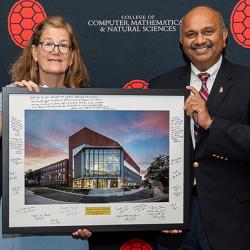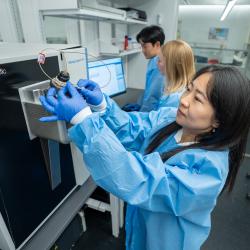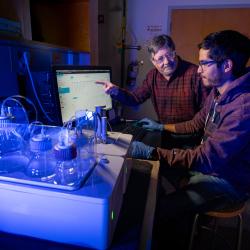Much More Than Just a Building
Associate Professor Efrain Rodriguez sees exciting new research opportunities ahead with new multimillion-dollar chemistry and biochemistry facility
Efrain Rodriguez has a big move coming up. The associate professor and his colleagues in Wing 1 of the University of Maryland’s chemistry complex are clearing out their research labs to prepare for a major construction project that’s been years in the making.
“It’s a little like musical chairs,” Rodriguez said. “Right now, I’m packing up my lab and moving to Wing 3 where we’ll be temporarily for probably around two years. Most of the major instruments we use for studies like X-ray crystallography are also in Wing 1, so they’re all moving to various parts of the chemistry and biochemistry complex as well. But for us, it’s a very small sacrifice to be in a new building in the future.”
This summer, Wing 1 will be demolished to make way for the Department of Chemistry and Biochemistry’s next big thing—a brand new, multimillion-dollar research facility set for completion in late 2023. For years, a committee of UMD representatives, architects and construction experts has been working on plans to replace the aging chemistry wing with a new 105,000 square foot state-of-the-art research facility. Rodriguez has been a faculty leader on the planning committee since 2019.
“Chemistry has been wanting to replace this older wing for a very long time,” Rodriguez explained. “My role has been to give feedback to the architects, the construction folks, and others in the college and university. What exactly should these new labs look like for doing research—not just today, but 10, 20 years from now? We offer input on everything from the nitty-gritty, like placement of fume hoods, to the kinds of instrumentation that will push our research programs and projects forward.”
The new building is designed to expand the department’s research program, accelerating innovation in key areas such as nanomaterials, energy and environmental sustainability, soft matter and biomolecular science. With a forward-thinking design that includes flexible laboratories that facilitate targeted research collaborations and laboratory facilities that can handle sensitive materials and complex research protocols, the new building will be ideal for Rodriguez’s work in materials and solid-state chemistry.
“I work on tailoring inorganic materials to achieve different functional properties,” he said. “One of the materials areas that I work in is making quantum materials, which has a lot of overlap with other units on campus, like the Quantum Materials Center and physics. I also create materials for defeating and degrading chemical warfare agents; I work with the Army on that project.”
Rodriguez’s work designing and synthesizing energy-related materials and novel quantum materials is highly sensitive to oxygen and moisture, which presents a unique set of challenges.
“Currently we work a lot in glove boxes to control air quality and we have a lot of high-temperature furnaces that can go up to 1500 degrees Celsius,” Rodriguez said. “I’m always worried about heat load and other issues we can get from these furnaces.”
Labs in the new building will have an advanced climate control system that will give researchers the ability to control the conditions, something Rodriguez isn’t able to do now.
“When you’re in an older building, you really have to fight the fact that you don’t control humidity and temperature,” he explained. “In the new lab, the way that we’ll have precise control over the atmosphere and temperature makes me confident that we will be able to do experiments we haven’t done before.”
The infrastructure of the building is designed to have a catalytic effect on research, learning and collaborative opportunities for students as well.
“We’ll be placing labs close to each other in a way that will facilitate collaborative projects more, so there will be more cross talk between different research groups,” Rodriguez noted. “That’s good for students because they’ll be able to do better quality research. And more opportunity for collaboration means there’s more opportunities for them after they complete their Ph.D., which opens up more of the world to them.”
Rodriguez is especially interested in one particular area in the building’s footprint: a unique space designed for hosting large lectures and other special events.
“It’s going to be a place where we’ll be really proud to invite big speakers,” he said. “For example, last year we brought in the 2019 Nobel laureate in chemistry for the Tobin J. Marks Lecture. I think we’ll be bringing in more Nobel laureates of that caliber in the future and having this fantastic conference room where they can present and interact with our faculty and students and alumni is going to be really cool.”
For Rodriguez and the many others involved in the planning for the new chemistry facility, there’s more to this effort than just putting up a new building to replace an older one. It’s a project that sets the stage for the future of chemistry and biochemistry at UMD, and Rodriguez hopes alumni and members of the community will want to be part of it.
“I hope they’ll want to join us in supporting this project,” Rodriguez said. “It’s a fantastic opportunity to renovate—and not just in the physical sense,” he explained. “Obviously, in the physical sense we’ll have this new beautiful space, but this is also about how we interact within the department and what research goals we put forward in the future.”
From opening up new research frontiers to taking on the grand challenges facing our world, the new chemistry wing will enhance the department’s world-renowned reputation as a powerhouse in research and training in the chemical sciences.
For Rodriguez and his colleagues in chemistry’s old Wing 1, making a big move now means moving ahead toward an exciting future.
“It’s always important to dream big, and this has been a really fun process. We need this building to move forward and we’ve needed this for a very long time,” Rodriguez said. “I’m confident that we will be a stronger department 10 years from now in several research areas, and I definitely think that the people we’ll be able to recruit with the new chemistry building will play a really large role in that. We’re excited about what it will mean for our department for decades to come.”
Written by Leslie Miller
————————————
We Need Your Help!
While we have the base budget to construct the building, we need to raise private funding to outfit these new research labs with state-of-the-art equipment and keep them up to date for years to come.
If you are interested in helping us push the frontiers of chemistry by supporting this new facility, you can make a gift online by visiting go.umd.edu/chemrenovationfund.
To talk about additional opportunities, such as naming a research lab or other space in the new facility, please contact Cheri Meadows at 301.405.9624 or meadows@umd.edu.







